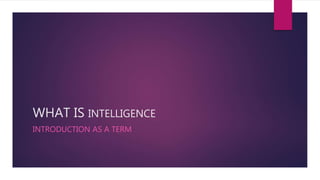
What is intelligence
- 1. WHAT IS INTELLIGENCE INTRODUCTION AS A TERM
- 2. GROUP 25 ALI RAZA 2018-AG-713 ADNAN HAMID 2018-AG-754 KAFAYAT ULLAH 2018-AG-783 JAVED IQBAL 2018-AG-610 M. ASIF 2018-AG-696
- 4. DEFINITION Intelligence is goal directed and adaptive behavior. A property of the mind that encompasses many related abilities, such as the capacities to reason, to plan, to solve problems, to think abstractly, to comprehend ideas, to use language, and to learn.
- 5. THEORIES OF INTELLIGENCE Charles Spearman - General Intelligence Louis L. Thurstone - Primary Mental Abilities Robert Sternberg - Triarchic Theory of Intelligence Daniel Goleman-Emotional intelligence model
- 6. Charles Spearman - General Intelligence: Spearman proposed that two factors could account for individual differences in scores on mental tests. He called the first factor general intelligence or the general factor, represented as g. According to Spearman, g underlies all intellectual tasks and mental abilities. The g factor represented what all of the mental tests had in common. Scores on all of the tests were positively correlated, Spearman believed, because all of the tests drew on g. The second factor Spearman identified was the specific factor, or s. The specific factor related to whatever unique abilities a particular test required, so it differed from test to test.
- 7. Louis L. Thurstone - Primary Mental Abilities Psychologist Louis L. Thurstone (1887-1955) offered a differing theory of intelligence. Instead of viewing intelligence as a single, general ability, Thurstone's theory focused on seven different "primary mental abilities" (Thurstone, 1938). The abilities that he described were: Verbal comprehension Reasoning Perceptual speed Numerical ability Word fluency Associative memory Spatial visualization
- 8. Robert Sternberg - Triarchic Theory of Intelligence Psychologist Robert Sternberg defined intelligence as "mental activity directed toward purposive adaptation to, selection and shaping of, real-world environments relevant to one’s life". Sternberg proposed what he refers to as 'successful intelligence,' which is comprised of three different factors: Analytical intelligence: This component refers to problem-solving abilities. Creative intelligence: This aspect of intelligence involves the ability to deal with new situations using past experiences and current skills. Practical intelligence: This element refers to the ability to adapt to a changing environment.
- 9. EMOTIONAL INTELLIGENCE The Emotional Competencies (Goleman) model The model introduced by Daniel Goleman focuses on EI as a wide array of competencies and skills that drive leadership performance. Goleman's model outlines four main EI constructs: Self-awareness — the ability to read one's emotions and recognize their impact while using gut feelings to guide decisions. Self-management — involves controlling one's emotions and impulses and adapting to changing circumstances. Social awareness — the ability to sense, understand, and react to others' emotions while comprehending social networks. Relationship management — the ability to inspire, influence, and develop others while managing conflict.
- 10. Major Approaches to Intelligence I.Q Tests (General measures of intelligence) Fluid and Crystallized Intelligence (Fluid intelligence relate to reasoning, memory. Crystallized relates to information, skills and past experiences) multiple intelligence. Practical intelligence (intelligence in terms of non academic and personal success). Emotional intelligence (understanding of emotions)
- 11. Gardner’s multiple intelligence The intelligence types were: Linguistic and verbal intelligence: good with words Logical intelligence: good with math and logic Spatial intelligence: good with pictures Body/movement intelligence: good with activities Musical intelligence: good with rhythm Interpersonal intelligence: good with communication Intrapersonal intelligence: good with analyzing things Naturalist intelligence: good with understanding natural world.
- 12. FORMULAE OF I.Q (William Stern ) MA / CA X 100 Mental age divided by chronological age multiplied by hundred. The mean I.Q. for the general population is 100.
- 13. Factors affecting intelligence Biological Environmental.
- 14. TESTS Aptitude Tests predict a person’s ability in specific area. (SAT and GRE) Achievement Test determine the specific level of knowledge in an area. (F.SC or A- Levels)
- 15. GROUP TEST Army Alpha Intelligence Test: During World War I (1914-1918) the United States Army asked educational psychologists to develop an intelligence test for recruits. Paper pencil test. Army Beta: During World War I (1914-1918) the United States Army administered intelligence tests. The Army Beta exam, which posed nonverbal problems, was given to non-English speakers and illiterate recruits.
- 16. Intelligence depends not only on I.Q but many factors such as motivation, skills personal and emotional maturity and environmental factors.